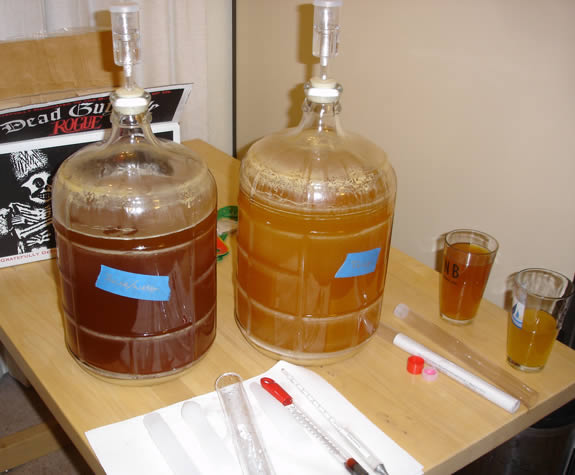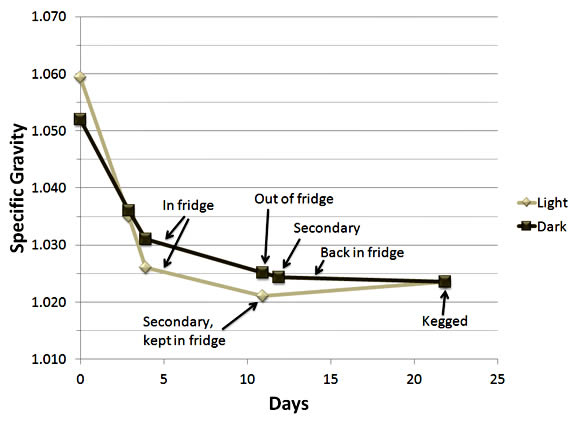
Menu:
Spire Dark
Kegged on October 4, 2010.
After making a few batches of cider, I decided to try to copy one I had tried from a store. The cider I chose to copy was Spire Dark & Dry Apple Cider. I chose this cider because it was the favorite of a friend and also because it had additional ingredients to add flavor. It would be very difficult to replicate a plain cider because the flavor will depend on the variety of apples used as well as the type of yeast, which is information that would be hard to come by. This cider says it has "a hint of molasses and brown sugar," so I knew what I needed to add.
I bought a few bottles of the Spire cider and poured some into a graduated cylinder so I could check the specific gravity, which turned out to be 1.021. I knew the cider had an alcohol content of 5.0%, so my target original gravity would be 1.059. I chose the Kirkland Signature Organic Apple Juice and Wyeast French Saison (3711) yeast. The Kirkland juice has a specific gravity of 1.053, which means I would need to add about 2.4 ounces of sugar per gallon of juice to get the correct original gravity. I again decided to split the batch into two versions, one would use 2.5 gallons of juice, three fluid ounces of molasses, and three fluid ounces of brown sugar, the other would use 1.5 gallons of juice, one gallon of water, nine fluid ounces of molasses, and nine fluid ounces of brown sugar. I wanted to give one version more molasses and brown sugar to add more flavor from those ingredients so I could try to figure out the appropriate amount to recreate the Spire cider, I used less apple juice so I would have the same amount of sugar in both versions. Unfortunately I made an error calculating the amount of molasses and brown sugar to add to the version with only 1.5 gallons of apple juice, instead of nine fluid ounces of each, the amount should have been closer to 13.5 fluid ounces of each. This means the version I made with a stronger molasses and brown sugar flavor would have less alcohol.
I heated the molasses and brown sugar for each version to kill anything that might have been growing in those ingredients and also to make the molasses flow more easily into the carboys. I poured the molasses and brown sugar mixture through a funnel into each carboy and then added the juice to wash everything into the carboys. I then added the yeast to each version. To hit the correct final gravity I had to take regular samples from each carboy, below is an image after I took samples for each type of cider.

I checked the specific gravity of each cider every few days. When they got close to my target endpoint I placed each in my fridge to slow fermentation. I ended up taking the dark version (the one with more molasses) back out of the fridge for a few days because its specific gravity was still too high. The graph below shows the specific gravity of each cider over time.

On the graph above, the specific gravity reading for the light cider increases before kegging, there are several possible reasons for this error. One possible explanation is that because the sample taken for measurement was so small, its temperature could have increased significantly after being removed from the fridge (the temperature used was the temperature of the fridge). There also could have been bubbles on the hydrometer from natural carbonation during the final reading that would give an artificially high value by making the hydrometer float higher.
The original gravity for the light cider was calculated to be 1.059; the value for the dark cider was around 1.052. Both of my calculated values are probably higher than the true specific gravity because I did not take into account the density or mass percentage of sugar for the molasses and brown sugar; density would be required because I measured the ingredients by volume instead of mass. The light cider was in the primary container for 11 days, followed by 11 days in the secondary container, for a total of 22 days. The dark cider was in the primary for 12 days, followed by 10 in the secondary, also for a total of 22 days. The final gravity for both ciders was 1.024, resulting in an alcohol content of 4.7% for the light cider, and 3.7% for the dark cider.
I was very happy with how both of these ciders turned out. They were both a little different than the real Spire cider, but not in a bad way. Mixing equal parts of each cider together resulted in the closest match to the real version. In future versions I would like to come closer to my target of 5.0% alcohol.